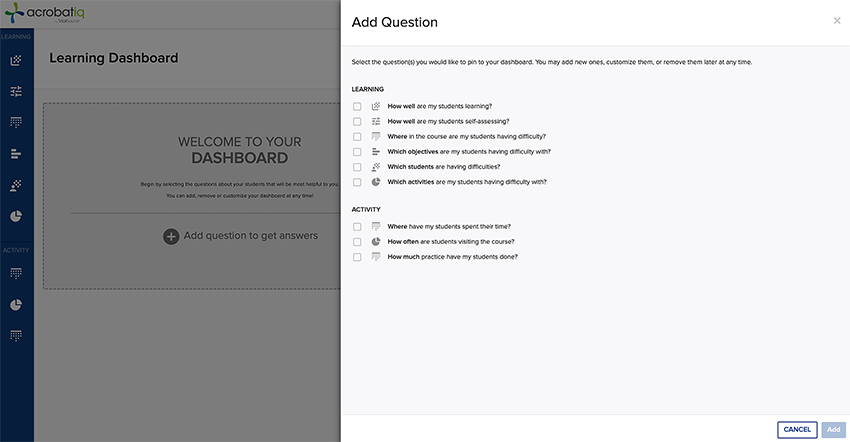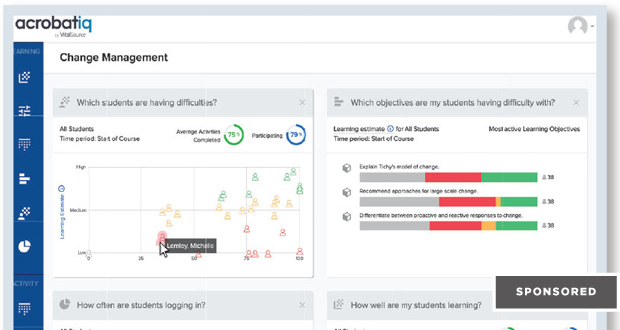The idea of implementing personalised learning at your institution may be a daunting one. When will you find the time to create the courses? How can you be sure content is linked to the correct learning objectives? Will personalisation and adaptivity really benefit your students? Acrobatiq® by VitalSource can answer all of these questions. Born out of the Open Learning Initiative (OLI) from Carnegie Mellon University, Acrobatiq has made leveraging publisher-provided courseware easier than ever. Employing the methodology that core content should remain just that, with adaptive assessments being deployed alongside to give targeted help to meet individual needs, you can ensure all students will receive the necessary, fundamental materials along with adaptive content both during the course and before it starts.
When will you find the time to create the courses?
Personalised learning with Acrobatiq can be procured from various sources:
- Publisher content
- Content created by your institution
- Acrobatiq’s Fast-Start Content Library
- Open educational resources (OER)
Don’t have your own content and have no idea where to start? Adopting publisher-created content can save time and a considerable amount of effort when it comes to implementing personalised learning at an institution. Whilst publisher content cannot be directly altered, instructors are able to change the order of topics, hide topics, and hide any learning objectives they do not feel are relevant. However, with Acrobatiq’s SmartAuthor, other changes can be made by adding curriculum-relevant content to enhance the course.
Already have original content created by your institution or OER you have revised and remixed that you don’t want to go to waste? SmartStart, an intelligent content ingestion engine, provides an easy way to deliver courseware that reduces development time down to just two hours. Simply upload your EPUB content into Acrobatiq’s system to see it quickly converted to courseware, with AI-generated formative practice and lessons automatically tied to learning objectives.
How can you be sure content is linked to the correct learning objectives?
Acrobatiq’s powerful personalised learning engine uses natural language processing and machine learning models to find learning objectives in the content, aligning them to the right topical lessons. SmartStart generates over a thousand questions that align to the learning objectives by allowing the AI to identify the most important sentences in any given lesson to create practice questions. You and your institution don’t have to worry about linking content to learning objectives—Acrobatiq can do it for you.
Will personalisation and adaptivity really benefit your students?
In 2017, research undertaken at the Western Governors University’s (WGU) psychology programme used final exam data before and after Acrobatiq adoption to find the correlation between personalised, adaptive learning and improved outcomes. The most notable improvement was that of students receiving the Pell Grant, a subsidy from the US federal government that pays for students to attend college, largely assisting undergraduates from low-income families. Before the Acrobatiq adoption, there was a 14-point difference of pass rate with these students and those not receiving the grant. When using Acrobatiq, this difference could hardly be seen, raising their final exam scores and effectively closing the gap experienced by Pell students.
The Higher Education Participation and Partnerships Program (HEPP) contributes funding to institutions to help students from lower socio-economic backgrounds. It is also important to remember that 50% of students in Australia are first generation who are not covered by HEPP, and that 26% of those from this demographic indicate they are likely to drop out in Year 1. The WGU research student profile heavily consisted of first-generation students, with 46% of the 1,898 participants sitting within this demographic. There was an 8-point difference in percentage of the 1,204 who used Acrobatiq, and the remaining 694 who were in the control group. This statistic, alongside the indicators that the Pell gap is closed, go to show how important personalised and adaptive learning can be for underrepresented and first-generation students when it comes to retention and outcomes. With government performance requirements set to change in Australia in 2020—with factors such as “equity group participation, measured by participation rates for Indigenous, low socio-economic status, and regional and remote students” being used to determine levels of funding at universities—adopting personalised learning, which has a proven positive impact on this demographic, seems like an obvious solution.
Using the analytics made available from personalised learning, instructors can identify at-risk students and have more meaningful conversations with students by seeing which specific learning objectives they are struggling with, leading to deeper insights into the content students might find challenging or important.
Instructors can easily choose the data they wish to see based on their interests, in turn:
- Revealing what students did/did not learn
- Quantifying how well students have learned each skill or key competency
- Identifying consequential patterns in students’ learning behaviours
- Measuring effectiveness of instructional design, including identifying underperforming content
- Personalising the learning experience for students

Data points such as “Which objectives are my students having difficulty with?” and “Which students are having difficulties?” allow instructors in-depth understanding into study habits, students’ mastery of objectives, and those who are likely to drop out. The beauty of personalised learning is that if Student A is excelling at Module 1 but Student B is falling behind, instructors can deploy added learning materials to only Student B, ensuring all students feel like individuals. With students in a recent survey saying “although assessment tasks provide feedback, there is little opportunity to receive personalised feedback on my academic progress” and that “feedback from tutors and lecturers is too brief and generic,” personalised learning and the analytics that come with it seem to be the perfect duo to combat this.

It can tackle more than this, though. With other aspects concerning “student success, measured by the drop-out (attrition) rate and student experience” coming into play in the new performance-based funding allocation scheme, institutions should be seeking out ways to improve these, such as embracing personalised learning.
To read our research brief and book a demo of Acrobatiq, visit https://news.acrobatiq.com/campus-review.
Do you have an idea for a story?Email [email protected]
 Campus Review The latest in higher education news
Campus Review The latest in higher education news


